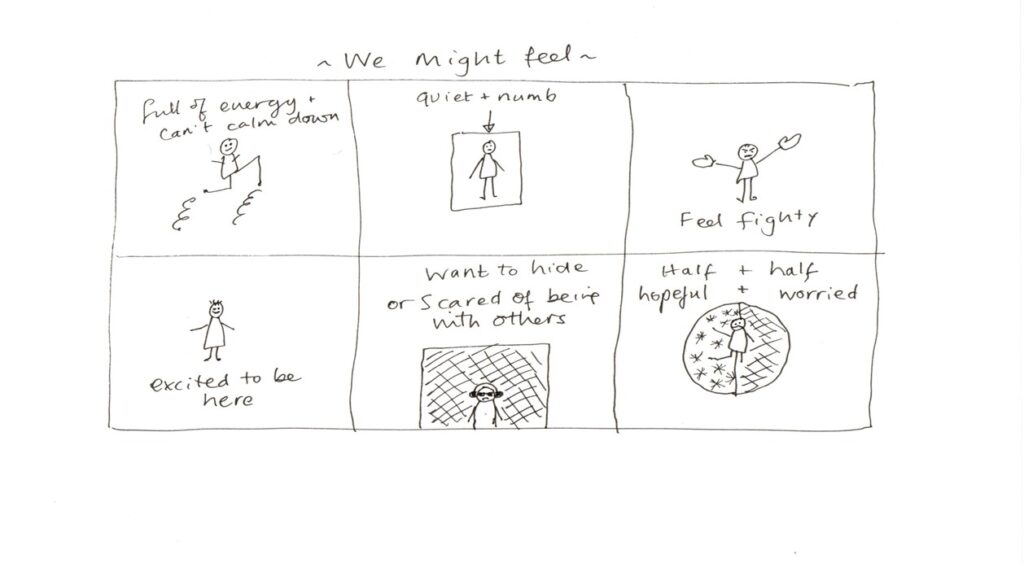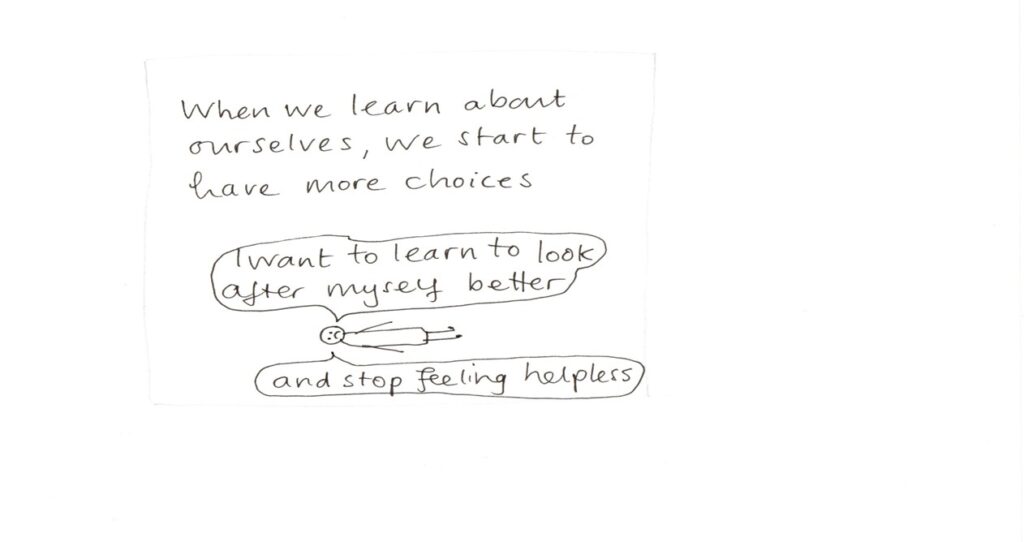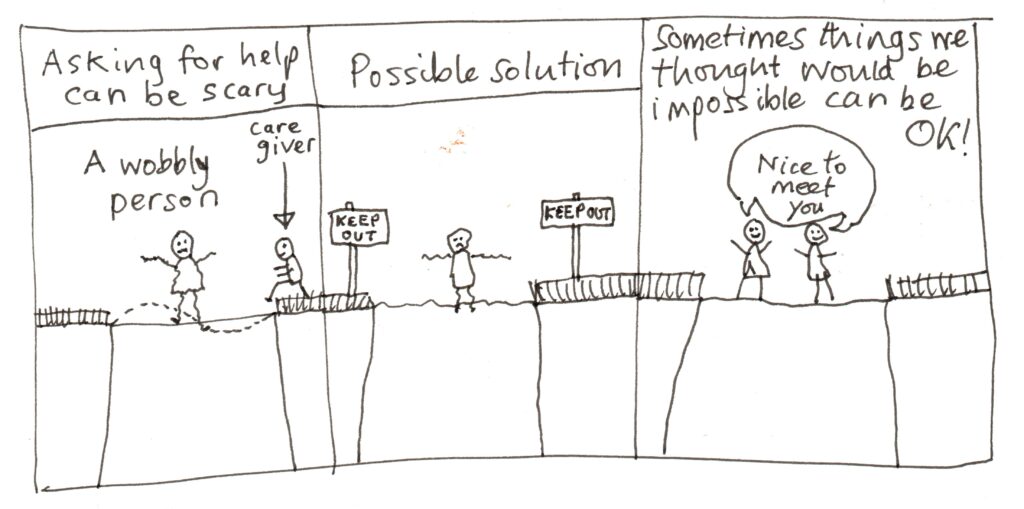Psychoeducation in art therapy
Hot topic
In our first hot topics article looking at developments in art therapy, Joanna Stevens talks about psychoeducation in art therapy practice.

What is psychoeducation?
Psychoeducation is a therapy intervention where the therapist provides people, and their relatives or friends, with information they need to understand and manage their condition or the difficulties they are experiencing. In the last few decades, psychoeducation has emerged as an effective evidence-based practice in both clinical trials and community settings.
Through psychoeducation we can learn more about ourselves, our physical and mental health, and psychological experiences. The aim is to increase understanding, knowledge and skills and through this, enable a person to live with more wellbeing and vitality. At its core, psychoeducation is a learning process that teaches us we are not alone, our sense of safety can be built, and other people can be helpful.
The delivery of psychoeducation is ideally collaborative: the therapist skilfully shares knowledge and ideas about human experience, empathetically offering these alongside the service user’s lived experience. Through this process, a map and language emerge to support therapeutic work and offer each person new resources.
What we learn can support us as an orientating tool, helping us notice and understand more about what we experience; and as a language-making tool, helping us find words to communicate our experiences. It may deepen our understanding of ourselves and give us new ways to connect with others. It can also be useful for the friends, family and carers around us, providing vital information about how best to help and what to expect when someone is unwell or struggling.
Why psychoeducation is relevant today
In the UK, art therapists must adhere to the Health and Care Professions Council (HCPC) Standards of Conduct, Performance and Ethics. Standard 1.3 explicitly states that art therapists ‘must encourage and help service users, where appropriate, to maintain their own health and wellbeing, and support them so they can make informed decisions.’ Psychoeducation fits well with this requirement.
Art therapists’ practice needs to incorporate the sharing of potentially useful knowledge or skills with those they offer care to. This is skilful relational work. Therapists do not want to impose or step in too quickly; however, neither should they withhold or miss opportunities to support learning, healing and health.
We do not want someone to struggle when there might be relevant knowledge, useful resources, or helpful skills that we could support them to access. Effective psychoeducation can help therapy avoid re-enacting the trauma of neglect, where someone is left to manage alone with insufficient support, care and attention from another.
Psychoeducation can be delivered both formally and informally within art therapy practice. Formal means it is a planned, explicit and structured part of a therapeutic intervention. Informal psychoeducation introduces or addresses particular topics as they arise or seem most relevant.
Psychoeducation and art therapy
As a profession, we are beginning to explore what specifically art therapy-based psychoeducation looks like. Many art therapists already use psychoeducation within their practice. It seems there could be real benefit in having a wider dialogue and investigation into the use of psychoeducation across the profession to share and develop practice together.
However art therapists approach psychoeducation, the aim is to integrate it into art therapy, so it feels ethically, intellectually and emotionally connected, not unrelated or imposed.

Art therapy has unique scope when it comes to psychoeducation. Art therapists have so many art-based and relational skills to help us develop and support learning opportunities, especially using visual imagery to create effective communication tools and accessible resources.
Art therapists can ensure that psychoeducation is focused and relevant by working closely with people during art therapy sessions and asking: is this helpful, does this connect with you, does it fit with your life, would you like to know more?
Psychoeducation in art therapy can include:
- Helping participants learn about how to make use of art therapy.
- Communicating psychological ideas, knowledge and skills to individuals and groups.
- Encouraging participants to apply these ideas, knowledge and skills to their own lives and show interest in the meanings and uses they make of them.
- Learning from each other through the dialogue that takes place in the therapy as a result of the art-making process and reflecting on lived experiences.
How psychoeducation can help
Service users may benefit most when the psychoeducational materials and practice are:
- Relevant to their context and life.
- Accessible – the information, knowledge or skills can be understood. We want to build a person’s sense of competence and capacity to learn rather than to leave them undermined, intimidated or shamed.
- Relational with the opportunity to be with the person or group as they seek to explore and apply the learning to their own life and experiences. Psychoeducation can play an important role in that exploratory movement between concept and experience and back again.
- Reminders that can continue to be of use and relevance after therapy sessions have ended.

An example from my practice
In my role as clinical lead and art therapist in an NHS specialist service for people with complex emotional and relational needs, the people I worked with had often lost trust in interpersonal relationships and their own value and agency. The work of supporting engagement and building sufficient feelings of safety for curiosity to emerge was essential.
One of the many ways I approached this was through drawing comics; each one was used to communicate ideas about the dynamics of human relationships (Heard, Lake and McCluskey, 2012). Our weekly art therapy and attachment group started with a grounding exercise and check-in, after which I would introduce a new comic. The first one explored what we might experience when joining a group and ways in which critical judgements might get in the way of working with the art materials.
Over the weeks we worked from comics about care seeking, care giving, self-defence, interest sharing, intimacy, the internal supportive or unsupportive environment and the external supportive or unsupportive environment. The group included time for art-making and sharing images and associations to the material I introduced. Here are some quotes from the group:
Did you write a comic on my life? It was as if I was seeing my life. Seeing those pictures was seeing me and how I felt when people get close.
Group participant
I found the comics held my attention and gave the group a good starting point for discussion as it can be a difficult topic to discuss as our experiences of care seeking haven’t necessarily gone well.
Group participant
Learn more about psychoeducation
Explore how to effectively integrate psychoeducation into your clinical work in our 2-day course.